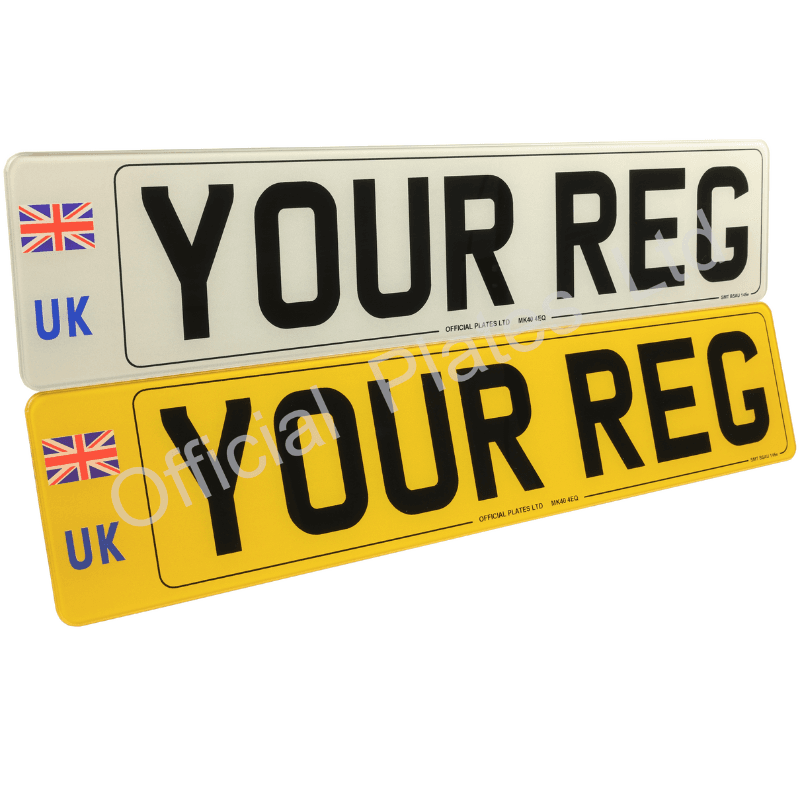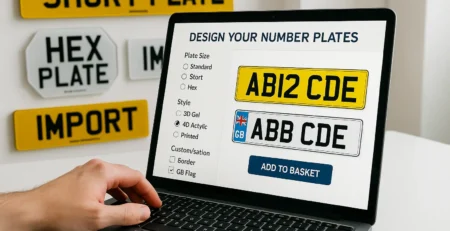Driving from the UK to Europe – Number Plate Rules & Requirements (2025 Guide)
DVLA-registered number plate supplier – Road-legal UK identifier plates
If you’re planning to drive from the UK to Europe, it’s important to ensure your number plates and vehicle documents meet the legal requirements — especially following the post-Brexit regulatory changes.
This guide explains the updated rules for UK number plates, UK identifiers, GB plates, UK stickers, and the legal equipment you must carry.
As a DVLA-registered supplier, we manufacture fully road-legal UK identifier plates suitable for use across Europe.
⚡ Quick Answer – What Number Plate Do You Need to Drive in Europe (2025)?
- Your number plate must show the “UK” identifier with the Union Jack flag
- GB plates are no longer valid anywhere in Europe
- If your plate does not have “UK”, you must fit a UK sticker
- Spain, Cyprus & Malta require a UK sticker even if your plate includes the UK identifier
- EU-style plates with European stars also require a UK sticker
UK Number Plate Rules for Driving in Europe (Post-Brexit)
1. The UK Identifier – The Legal Standard
Since 2021, the UK uses UK + Union Jack as the official identifier for vehicles travelling abroad. This replaces the old GB marker.
If your number plate displays the UK identifier and meets BSAU 145e standards, you are compliant for most European countries without needing an extra sticker.
2. Are GB Plates Still Valid?
No. GB plates and GB stickers were retired and are no longer recognised in Europe.
If your vehicle still shows “GB”, you must either:
- Fit a UK sticker, or
- Replace your plates with new UK identifier plates
For regular travellers, replacing your plates is the cleanest and most professional option.
👉 Replace GB plates with UK plates
3. When You MUST Display a UK Sticker
Even if your number plate already has the UK identifier, a physical UK sticker is required in:
- Spain
- Cyprus
- Malta
For all other European countries, a UK sticker is only needed if your number plate does NOT show “UK”.
Country-by-Country UK Sticker Requirements
| Country | UK Sticker Required? | Notes |
|---|---|---|
| Spain | Yes | Required even with UK identifier plates |
| Cyprus | Yes | Mandatory |
| Malta | Yes | Mandatory |
| France | No | UK identifier plate accepted |
| Germany | No | UK identifier plate accepted |
| Italy | No | UK identifier plate accepted |
| Belgium | No | UK identifier plate accepted |
| Netherlands | No | UK identifier plate accepted |
| Austria | No | UK identifier plate accepted |
| Switzerland | No | UK identifier plate accepted |
🛂 Required Documents for Driving in Europe
- Valid UK driving licence
- V5C logbook
- Car insurance documents
- VE103 (if driving a hire/lease/company car
🦺 Safety Equipment Required in Europe
- High-visibility jackets (1 per passenger)
- Warning triangle
- Headlamp beam converters
- First aid kit (mandatory in Austria & Germany)
- Spare bulbs (recommended)
🌍 Low Emission Zone Stickers
Depending on where you drive, you may need:
- Crit’Air badge (France)
- Umweltplakette environmental sticker (Germany)
- Awareness of ZTL restricted zones (Italy)
Order these before you travel.
⚡ Electric Vehicles (EVs) Driving in Europe
Most European countries use CCS fast-charging. Major networks include:
- Ionity
- Shell Recharge
- Fastned
- Allego
Some cities allow EVs into low-emission zones without charges, but rules vary.
A. Yes — you need a UK sticker if your number plate doesn’t display the new UK identifier with the Union Jack, or if you’re driving in Spain, Cyprus, or Malta. Even if your plate includes the UK mark, these three countries still require a physical UK sticker.
A. No. GB plates and GB stickers were removed in 2021 and are no longer recognised in any European country. If your vehicle still displays “GB”, you must either apply a UK sticker or replace your plates with legal UK identifier plates.
Replace GB plates with UK identifier plates
A. To drive legally in France, your vehicle must display a number plate with the UK identifier or have a UK sticker fitted to the rear. GB plates are no longer valid anywhere in Europe, including France.
UK plates for Europe
A. In most EU countries, the UK identifier on your plate is sufficient. However, Spain, Cyprus, and Malta still require a physical UK sticker even if your plate already shows the UK identifier.
A. Yes, 3D and 4D plates are legal in Europe as long as they meet DVLA standards and comply with the BSAU 145e British Standard. They must also show the UK identifier or be used with a UK sticker.
Road-legal 3D & 4D plates
A. EU-style number plates with the European flag or stars are no longer valid on their own. If your plate shows an EU design, you must add a UK sticker to be compliant.
A. After Brexit, all vehicles travelling abroad must display the “UK” identifier, either built into the number plate or added as a separate UK sticker. GB plates are no longer recognised.
UK identifier number plates
A. Yes, but Spain is one of the countries that still requires a physical UK sticker, even if your plate already displays the UK identifier. This rule is strictly enforced.
A. Yes, UK identifier plates are recognised across Europe. The only exceptions are Spain, Cyprus, and Malta, where you must still display a UK sticker.
UK identifier plates
Driving with incorrect identifiers (such as GB plates) can result in fines, delays at borders, or being refused entry into certain countries. Updating to UK identifier plates ensures compliance everywhere in Europe.
Upgrade to UK plates
🧳 Final Checklist Before Traveling to Europe
- UK identifier plate or UK sticker
- Driving licence
- V5C logbook
- Insurance documents
- Breakdown cover
- Hi-vis jackets
- Warning triangle
- Beam deflectors
- Emission zone stickers
🛒 Need Road-Legal UK Identifier Plates?
As a DVLA-registered supplier, we manufacture:
- Road-legal UK identifier plates (BSAU 145e)
- Replacement plates
- 3D and 4D number plates




Leave a Reply